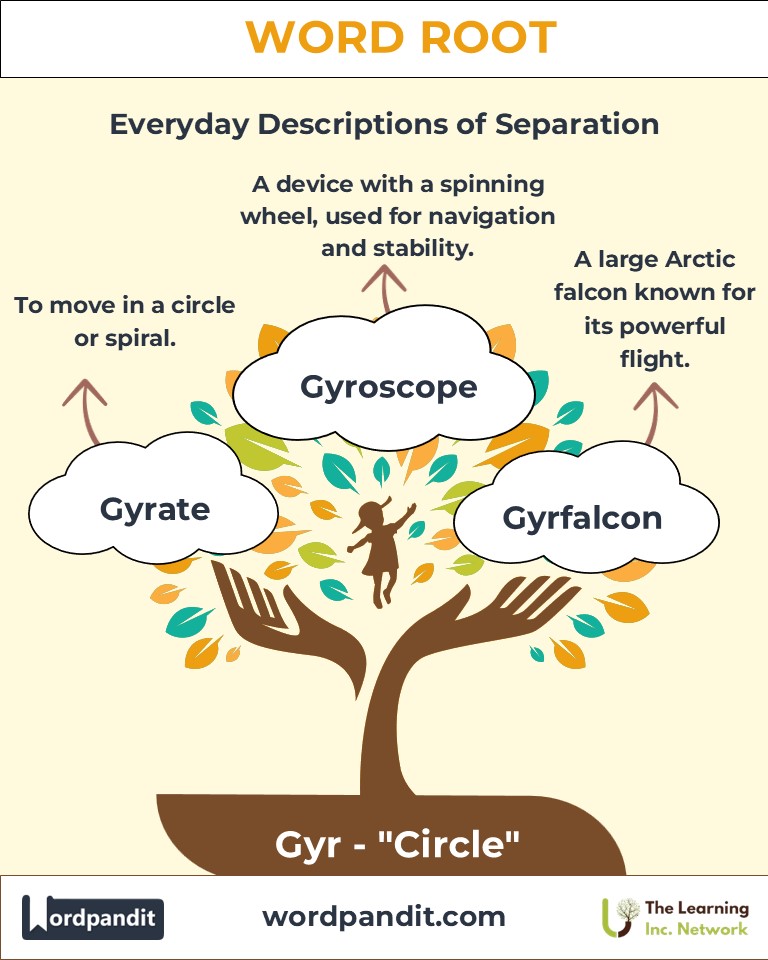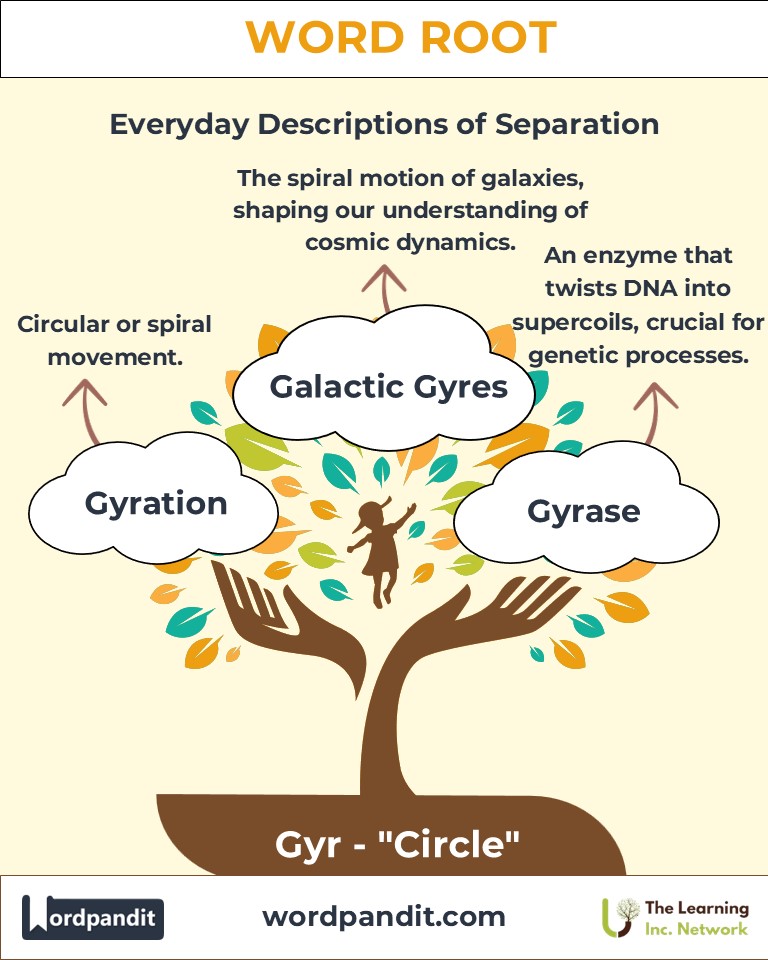Gyr: The Circle of Motion in Words and Concepts
Discover the fascinating world of the root "gyr," derived from the Greek "gyros," meaning circle. This root forms the basis of dynamic words like "gyrate" and "gyroscope," which convey rotation, motion, and circular patterns across disciplines, from physics to dance.

Table of Contents
- Introduction: The Essence of Gyr
- Etymology and Historical Journey
- Mnemonic: Unlocking the Power of Gyr
- Common Gyr-Related Terms
- Gyr Through Time
- Gyr in Specialized Fields
- Illustrative Story: Gyr in Action
- Cultural Significance of Gyr
- The Gyr Family Tree
- FAQs about the Gyr Word Root
- Test Your Knowledge: Gyr Mastery Quiz
- Conclusion: The Enduring Motion of Gyr
1. Introduction: The Essence of Gyr
When you hear "gyrate," do you picture a spinning dancer or a twisting object? The root "gyr" (pronounced "jīr") embodies the concept of circular motion. Originating from Greek, "gyros," meaning "circle," this versatile root appears in words related to rotation, revolution, and dynamic motion. Its applications span disciplines like mechanics, navigation, and art.
2. Etymology and Historical Journey
The root "gyr" comes from the Greek "gyros," meaning circle or ring. This term entered Latin as "gyrus" and later evolved into English, maintaining its association with circular or spiral movement. Historically, it was used in geometry to describe curves and later adopted in mechanical terms like "gyroscope," which revolutionized navigation and aviation.
3. Mnemonic: Unlocking the Power of Gyr
Mnemonic Device: "Gyr is the root of spinning and circles!"
To remember "gyr," visualize a spinning top drawing perfect circles on the ground. This imagery captures the essence of motion and circularity inherent in the root.
4. Common Gyr-Related Terms
- Gyrate (JAI-rayt)
- Definition: To move in a circle or spiral.
- Example: "The dancers began to gyrate rhythmically to the beat."
- Gyroscope (JAI-ruh-skohp)
- Definition: A device with a spinning wheel, used for navigation and stability.
- Example: "The aircraft relied on a gyroscope for precise orientation."
- Gyrfalcon (JIR-fal-kun)
- Definition: A large Arctic falcon known for its powerful flight.
- Example: "The gyrfalcon soared gracefully in circular patterns above the tundra."
5. Gyr Through Time
- Gyres in Poetry:
- Poets like W.B. Yeats used "gyre" to symbolize cycles of history and change, as seen in his poem The Second Coming.
- Gyroscopic Innovations:
- In the 19th century, gyroscopes were pivotal in the development of navigational tools, enabling precision in ship and aircraft travel.
6. Gyr in Specialized Fields
- Physics and Engineering:
- Gyroscope: Essential for stabilizing devices in aviation, space exploration, and robotics.
- Biology:
- Gyrase: An enzyme that twists DNA into supercoils, crucial for genetic processes.
- Astronomy:
- Galactic Gyres: The spiral motion of galaxies, shaping our understanding of cosmic dynamics.
- Art and Dance:
- Gyration: A key term in describing rotational movement in choreography.
7. Illustrative Story: Gyr in Action
Ella, a young scientist, worked tirelessly to design a gyroscope-based navigation system for drones. Inspired by the gyrations of falcons in the wild, she tested her prototype in the rugged terrain of the Andes. The device allowed the drones to stabilize in windy conditions, revolutionizing search-and-rescue missions. Ella’s innovation demonstrated how "gyr" connects the natural world with human ingenuity.
8. Cultural Significance of Gyr
The concept of circular motion resonates across cultures, symbolizing continuity and cycles. From the "mandalas" of Eastern traditions to the philosophical "eternal return," gyratory patterns embody the rhythms of life and the universe. The root "gyr" underscores humanity’s fascination with circularity in both thought and practice.
9. The Gyr Family Tree
- Cycl (Greek: circle):
- Cycle: A series of events repeated in the same order.
- Bicycle: A vehicle with two wheels.
- Orb (Latin: circle, sphere):
- Orbit: The curved path of an object around a star or planet.
- Orbital: Relating to or resembling an orbit.
- Spir (Latin: coil):
- Spiral: A curve that winds around a central point.
- Respire: To breathe, connecting to the rhythm of life.

10. FAQs About the Gyr Word Root
Q1: What does "gyr" mean, and where does it originate?
"Gyr" means circle or circular motion and originates from the Greek word gyros, meaning ring or circle. This root is central to words that describe rotation, spirals, and circular patterns in nature and technology.
Q2: What is a gyroscope, and how does it work?
A gyroscope is a device that uses a spinning wheel or disk to maintain stability and orientation. Its functionality is based on the principle of angular momentum, which keeps the spinning object resistant to changes in its axis of rotation. Gyroscopes are widely used in navigation systems for ships, airplanes, and smartphones.
Q3: What is gyration, and where do we see it in everyday life?
Gyration refers to the act of spinning or rotating in a circular or spiral motion. Common examples include the movement of a spinning top, the swirling motion of tornadoes, or the twists and turns in dance performances.
Q4: How is "gyr" applied in biology?
In biology, "gyr" appears in the term "gyrase," an enzyme that introduces supercoils into DNA. This coiling is essential for compacting DNA within cells and plays a critical role in DNA replication and transcription.
Q5: What are gyres in environmental science?
Gyres are large systems of rotating ocean currents, driven by the Earth's rotation and wind patterns. They play a crucial role in regulating climate and are also associated with marine debris accumulation, such as the Great Pacific Garbage Patch.
Q6: What are galactic gyres, and why are they important?
Galactic gyres refer to the spiral motion observed in galaxies, such as the Milky Way. These structures help astronomers understand the dynamics of galaxy formation, the distribution of stars, and the role of dark matter.
Q7: Is the root "gyr" limited to scientific terms?
No, while it is prevalent in scientific contexts, "gyr" also appears in artistic and cultural language, such as dance (gyration) or literature (as symbolic cycles in poetry, like W.B. Yeats's use of gyres in The Second Coming).
Q8: What role does "gyr" play in navigation?
The root "gyr" forms the basis of gyroscopic devices, which are essential for stabilizing and guiding vehicles like airplanes, ships, and spacecraft. Their precise measurement of orientation makes them indispensable in modern navigation systems.
11. Test Your Knowledge: Gyr Mastery Quiz
1. What does the root "gyr" signify?
2. Which device stabilizes motion using the principle of rotation?
3. What does gyration refer to?
4. Which bird's name derives from "gyr"?
5. What is the function of gyrase in biology?
12. Conclusion: The Enduring Motion of Gyr
The root "gyr" spins through language and science, connecting the motions of our world to our understanding of it. From the graceful gyrations of a dancer to the precision of gyroscopes guiding spacecraft, "gyr" encapsulates the dynamic beauty of circular motion. Explore its depth, and let it inspire you to appreciate the cycles and spirals that define life itself.











